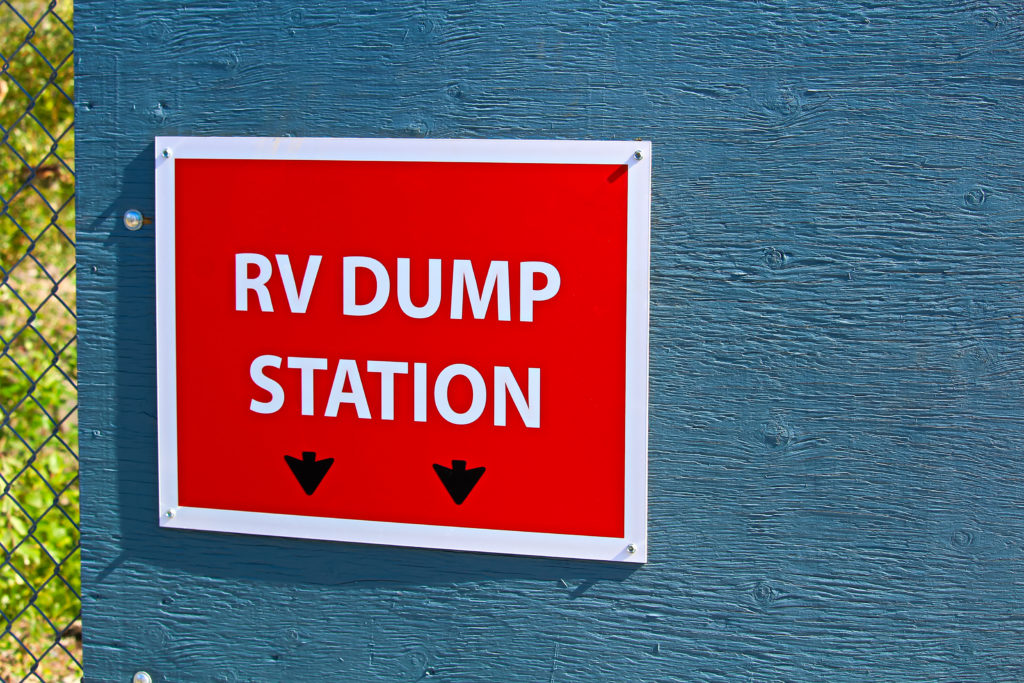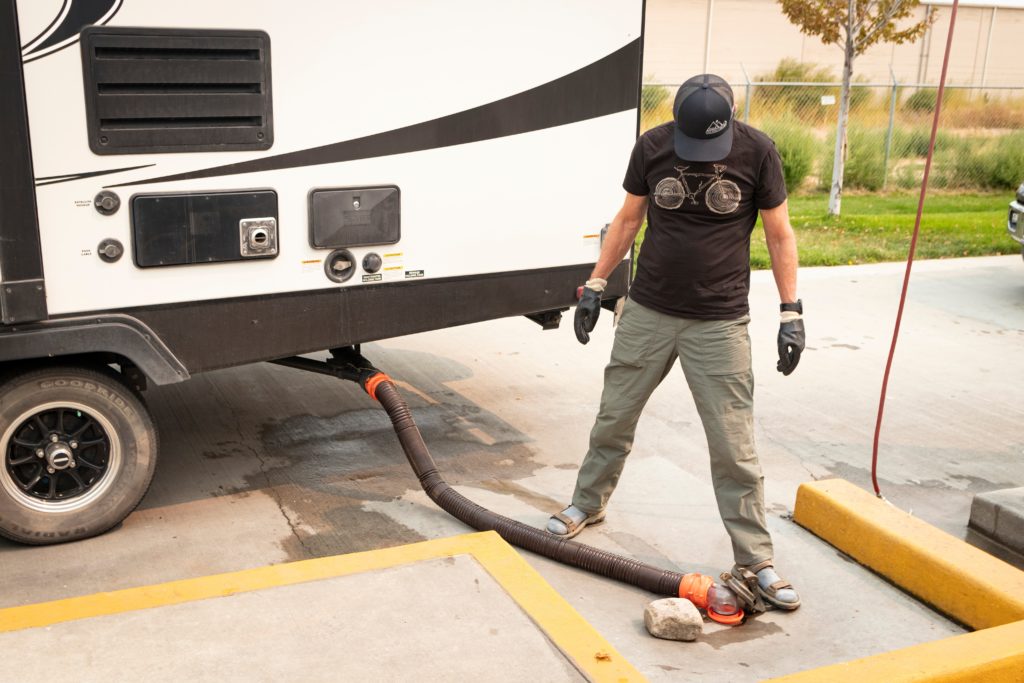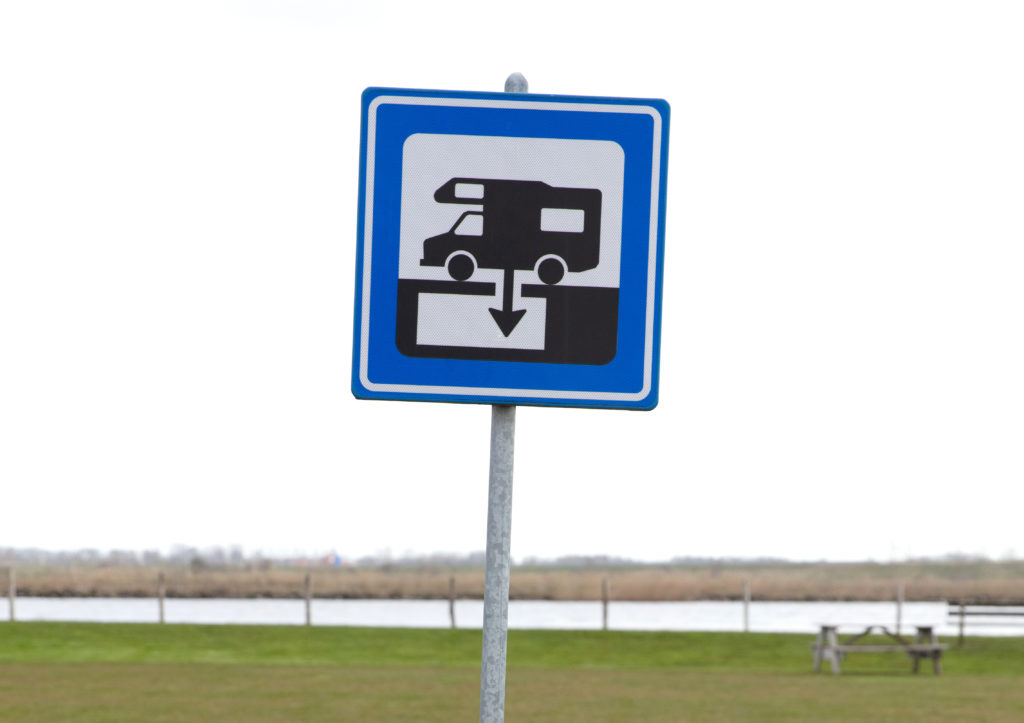Waste not, want not — it’s a way of life. Much like the RV life, the motto focuses on getting the most out of everything. The adventure. The journey. The destination. It applies to nearly every situation, every scenario, except one.
Actual waste.
When it comes to your RV waste, the only thing you want to know is where to dump it. We’ve gathered the details on how to find an RV dump station near you. It can be a dirty job, but someone must do it. And if that someone is you, it helps to know where you can dump your RV waste.
So, let us help.
What is an RV Dump Station?

Image: Shutterstock
Before finding one, it’s important to know what an RV dump station is. The last thing you want is to find it and then not know what its purpose is. Talk about waste — a waste of time.
An RV dump station is a designated pull-up area where RVers can empty their holding tanks. Your gray and black water tanks can be dumped and cleaned at a dump station before you’re back on the road again.
The best part about a dump station is it allows you to dump your tanks responsibly into an existing sewer system through a sewer hookup. They typically have conveniently placed water spigots for cleaning up your sewer hose or using your RV’s black tank flush.
How to Find an RV Dump Station Near You

Image: Benjamin Clapp / Shutterstock
If you’re staying at some of the best Good Sam Campgrounds, you will probably have access to a dump station onsite. But if you’re boondocking or between campgrounds, finding a dump station to empty your tanks every few days is a necessity.
When looking for an RV dump station available for public use near you, check the places below:
- Local campgrounds and RV parks
- Travel centers
- Rest stops
- RV service centers
- City wastewater treatment plants
- Sporting goods stores
- Boat marinas
While not all of these public locations will have an RV dump station, you now have a more complete list of your options when you need to get rid of RV waste. Even if they don’t have one, chances are someone there knows where a dump station is located close by.
If you’re staying with a friend or relative, you may be able to use their sewer clean-out to empty your RV’s holding tanks. This is typically possible whether they’re connected to a municipal sewer system, or their property boasts a septic tank.
It’s essential that the property owner knows you’re emptying your tanks and has given you permission to do so. Please don’t go around emptying RV waste into any residential clean-out you can find.
Find an RV Dump Station Online

Image: Camping World
Now, thanks to the Internet, finding an RV dump station is easier than ever. Include a quick search of RV dump stations along the way when you’re mapping out your next RV road trip so you don’t have to locate one in transit.
But a simple search sometimes leaves out pertinent details like times of operation or fees. For complete and accurate information regarding a specific dump station, try using one of the many apps or websites dedicated to RV dump stations.
Good Sam & Camping World RV Dump Service Locations
When you join Good Sam, you have access to RV dump stations located throughout the country. Several Camping World retail locations offer both propane refill and RV dump services.
Use this state by state directory to find a dump station near you and enjoy free dump station privileges with a Good Sam Membership.
How Much Does It Cost to Use an RV Dump Station?

Image: Shutterstock
While a Good Sam Membership grants you access to free RV dump stations, most dump stations charge a fee. If you’re hoping to only use free dump stations during your trip, it’s wise to thoroughly plan out your route including dump sites.
For those stations that do charge a fee, it’s typically a nominal fee ranging from $5 to $20, on average. Some campgrounds charge a small fee for non-campers to use their dump station. Regardless, it’s always a good idea to research the dump station so there aren’t any surprises once you arrive.
How to Empty & Maintain Your RV’s Holding Tanks
After you’ve done the research, planned the route, and arrived at the dump station, it’s important that you know how to empty and maintain your RV’s holding tanks. The last thing you want to happen is to arrive with full tanks and not know what to do with them.
Empty Your RV’s Holding Tanks
Emptying your holding tanks can be completed in 15 steps:
- Find the sewer hookup.
- Connect a water hose to fresh water.
- Wear PPE (Personal Protective Equipment).
- Retrieve your sewer hose and check the fittings.
- Connect the sewer hose.
- Use a sewer hose support.
- Identify black water and gray water handles.
- Dump the black water first.
- Empty your gray water tank next.
- Perform a preliminary freshwater flush.
- Use your black water tank flush.
- Close the handles and clear the hose.
- Disconnect your sewer hose.
- Perform a final rinse.
- Pack up and wash up!
Maintain Your RV’s Holding Tanks
While it’s important to empty your holding tanks, it’s even more important to maintain them so they’re always in tip-top working condition. Without your holding tanks, camping will inevitably be a lot more difficult than it needs to be.
Here are some additional tips for operating and maintaining an RV toilet.
Lighten the Load at an RV Dump Station

Image: Shutterstock
There’s no denying how much better you’ll feel after you locate and use an RV dump station, so don’t take them for granted. Plan ahead to make sure you’re in close proximity to one when you need it.
No one wants unnecessary baggage, especially in the form of waste, tagging along on their trip. With a few dump station locations mapped out in advance, emptying your holding tanks will be a quick process.
For more information on waste and holding tanks, check out the posts below:
- How to Treat Your Black Water Tank Right
- How to Sanitize Your RV Fresh Water Tank
- How to Use an RV Black Tank Flush
- What is an RV Tote Tank and Why You Might Need One
Do you have experience with RV dump stations? Tell us your tips and advice in the comments below!
By: Brad Cowan
Title: Where Can You Dump Your RV Waste?
Sourced From: blog.campingworld.com/rv-basics/maintenance/where-can-you-dump-your-rv-waste/
Published Date: Mon, 03 Oct 2022 19:00:42 +0000
---------------------------------------------
 CampingSurvivalistHuntingFishingExploringHikingPrivacy PolicyTerms And Conditions
CampingSurvivalistHuntingFishingExploringHikingPrivacy PolicyTerms And Conditions
